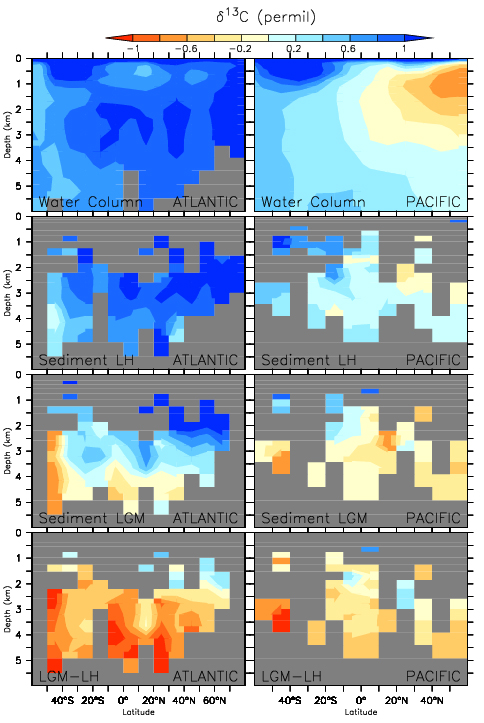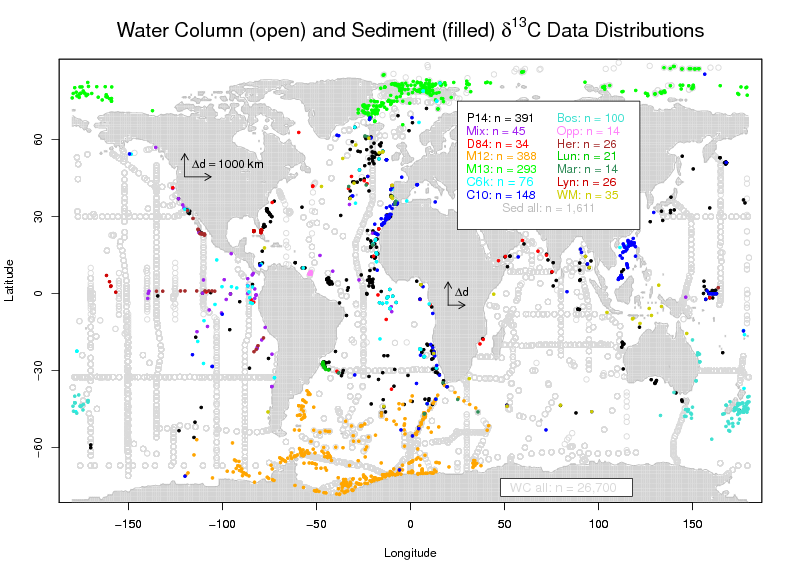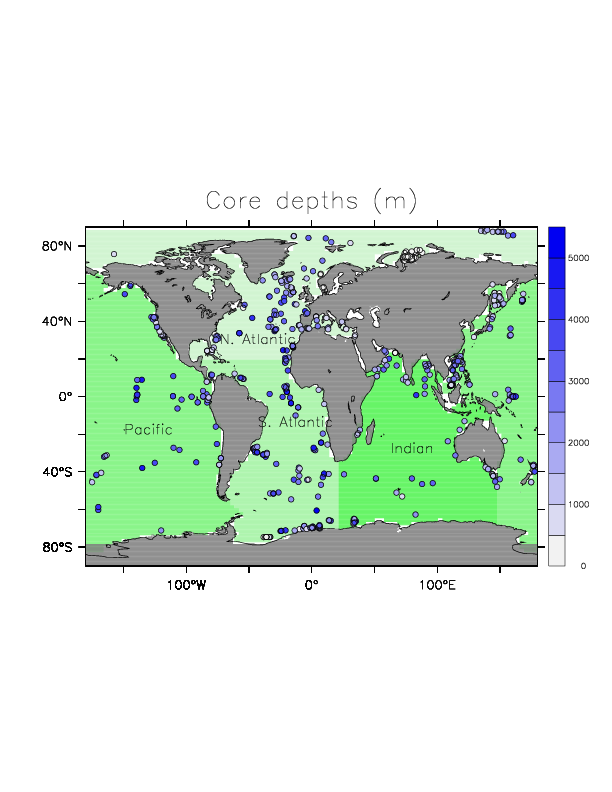Related Links
Description
Background
Changes in the amount of carbon stored in the oceans are thought to have played an important role in past variations of atmospheric CO2 and climate. Deep circulation controls the ocean's storage and redistribution of heat and carbon. Climate changes in turn affect physical (e.g. dust and iron supply, mixing, upwelling) and biological (e.g. plankton productivity) processes in the oceans. Recent model simulations imply that a combination of these processes could explain glacial-interglacial CO2 variations. New paleo data reveal the transition of circulation, atmospheric CO2, and climate from the Last Glacial Maximum, ~21,000 years ago, to the present in unprecedented detail including several rapid changes. However, the evidence from the deep ocean is still extremely limited.

Fig. 1: Observed δ13C distribution in the water column (top; Schmittner et al., 2013) and in surface (Late Holocene) sediments (second from top), in LGM sediments (third from top), and the LGM-LH difference (bottom). From Schmittner (2012; PAGES News).
Objectives
Stable carbon isotopes (δ13C) are routinely measured on shells of fossil benthic (deep dwelling) and planktonic (near surface) foraminifera and have been used for a long time as a proxy to infer both carbon cycling as well as deep ocean circulation in the past. A large number of data has therefore been measured. However, δ13C is determined by air-sea gas exchange as well as by biological processes, which made unequivocal interpretations difficult. Moreover, a global assessment of how reliably different species of foraminifera represent the water column has not been undertaken. These difficulties may have led to many measurements being unpublished and unreported. Fortunately, in recent years, process based models including δ13C have been developed and a new global dataset of water column δ13C measurements has been compiled. Here we propose a project to synthesize δ13C data from both benthic and planktonic foraminifera including unpublished and unreported data. Coretop data will be carefully compared to the water column measurements and errors and biases will be documented. Planktonic δ13C data will be calibrated using species specific equations. Downcore data will reveal changes in ocean circulation and carbon cycling and will be useful for comparison with other paleo data (e.g. from ice cores or speleothems) and transient model simulations. Focus of the downcore compilation will be on the last glacial cycle and in particular on the last deglaciation. Specific science questions addressed are:
- How did the deep ocean circulation change during the last deglaciation?
- How did ocean carbon cycling and storage change during the last deglaciation?
- How did deglacial changes in ocean circulation and carbon cycle affect climate and atmospheric CO2?
Funded by
Past Global Changes (PAGES)Workshops
Ocean Circulation and Carbon Cycling during the Last Deglaciation: Global Syntheses of Carbon Isotope Data, Cambridge, UK, September 6-9, 2018
Ocean Circulation and Carbon Cycling during the Last Deglaciation: Regional Syntheses of Carbon Isotope Data, Corvallis June 27-29, 2017
Deglacial Deep Ocean Circulation and Biogeochemical Cycling, Bern 2014
Data
Fig. 2: Map of current core-top (filled symbols) database together with the distribution of water column measurements (open). From Schmittner et al. (2017).
- Global dataset of δ13C water column measurements
- δ13C model code (works with UVic model version 2.8)
- The core-top database (Fig. 2).
- The down-core database is available here.
Regional Syntheses
OC3 plans to work on data syntheses and quality control in four regions. Each group is led by the following pair of scientists.
Publications
A global synthesis of high-resolution stable isotope data from benthic foraminifera of the last deglaciation
World Atlas of late Quaternary Foraminiferal Oxygen and Carbon Isotope Ratios
Active North Atlantic Deepwater Formation during Heinrich Stadial 1
Enhanced vertical mixing in the glacial ocean inferred from sedimentary carbon isotopes
Carbon Isotope Constraints on Glacial Atlantic Meridional Overturning: Strength vs Depth
Weak overturning circulation and high Southern Ocean nutrient utilization maximized glacial ocean carbon
Enhanced δ13C and δ18O differences between the South Atlantic and South Pacific during the last glaciation: The deep gateway hypothesis
Calibration of the Carbon Isotope Composition (δ13C) of Epibenthic Foraminifera
Presentations
People
-
Steering Committee
- Key Participants

